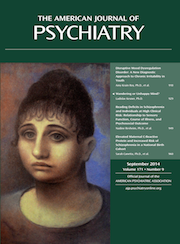Response to Majeske and Kellner
To the Editor: We thank Drs. Majeske and Kellner for their interest in our work and wish to provide clarification on the points raised.
Although it was not listed as a concern, we would like to emphasize that our statement that clozapine was used as a “last resort” was in the context of the psychopharmacological principle of monotherapy. We also intended to draw attention to the fact that although clozapine is considered a third-line medication, clinicians generally shy away from its use, especially in pediatric populations, until it is considered a “last resort” (1–4).
Regarding the concern that we neglected to consider the use of ECT in this case, Drs. Majeske and Kellner are correct, we did not consider it. The evidence for the use of ECT in children and adolescents with schizophrenia is limited to reports of its use as an adjunct to antipsychotic medication (5), and it is generally recommended that a patient has at least 2–3 adequate trials (adequate dosing and duration) of antipsychotic medication, including a trial of clozapine, before using ECT as an adjunct (5, 6). Given that our patient had not yet had an adequate monotherapy with clozapine, it would have been premature to engage her with adjunctive treatment with ECT.
We agree that it is important to consider all treatment options when managing childhood-onset schizophrenia. Our report is in no way intended to be exhaustive of the available treatments or treatment approaches (monotherapy, switching, combination, augmentation, etc.), but rather to provide a reference for providers using clozapine in children who encounter a fever.
1 : Clozapine use in children and adolescents. Expert Opin Pharmacother 2008; 9:459–465Crossref, Medline, Google Scholar
2 : Clozapine as treatment of first choice in first psychotic episodes: What do we know? Actas Esp Psiquiatr 2012; 40:281–289Medline, Google Scholar
3 : Childhood onset schizophrenia and early onset schizophrenia spectrum disorders. Child Adolesc Psychiatr Clin N Am 2013; 22:539–555Crossref, Medline, Google Scholar
4 : Management of clozapine-induced fever in a child. Am J Psychiatry 2014; 171:398–402Link, Google Scholar
5 : ECT for schizophrenia spectrum disorders, in Electroconvulsive Therapy in Children and Adolescents. Edited by Neera GWalter G. Oxford, United Kingdom, Oxford Press, 2013, pp 191–216Crossref, Google Scholar
6 : Treatment-refractory schizophrenia in children and adolescents: an update on clozapine and other pharmacologic interventions. Child Adolesc Psychiatr Clin N Am 2006; 15:135–159Crossref, Medline, Google Scholar



